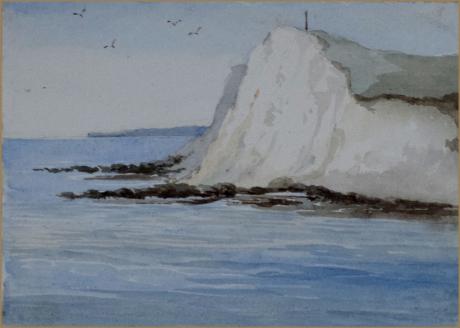inscribed and dated in the margin "Shakespear's Cliff, Dover 1872"
Shakespeare Cliff gets its name from its association with William Shakespeare:
"Come on, sir; here's the place: stand still. How fearful
And dizzy 'tis to cast one's eyes so low!
The crows and choughs that wing the midway air
Show scarce so gross as beetles: half way down
Hangs one that gathers samphire, dreadful trade!
Methinks he seems no bigger than his head:
The fishermen that walk upon the beach
Appear like mice; and yond tall anchoring bark
Diminish'd to her cock; her cock a buoy
Almost too small for sight: the murmering surge,
That on the unnumber'd idle pebbles chafes,
Cannot be heard so high. I'll look no more;
Lest my brain turn, and the deficient sight
Topple down headlong."
King Lear, Act IV scene VI - The Country near Dover.
Both the cliff and the coastline have changed dramatically over the years. Erosion has eaten away the cliff, producing falls of chalk. Man has had a far greater effect on the coastline, with the building of the Channel Tunnel. Shakespeare Beach is the stretch of shingle beach to the west of Dover Harbour, from the Admiralty Pier to Shakespeare Cliff. As a child, I used to climb over the hills on the right of the picture, down the steps and across the footbridge (not discernable in the picture) over the railway line to paddle in the sea.
At the top of the steps was a little shop where we would buy ice-creams and drinks; it was demolished a few years ago to make way for the new A20 road to Folkestone. At the end of the day we would trudge along the beach to the level crossing by the pier. From there we would catch a bus home. The level crossing is no more (the trains no longer go to the Marine Station). No buses go that way any more - the area is more or less derelict. Beyond the cliff lies the Warren and Folkestone. The single pier that forms Folkestone Harbour, and the town above it, can be seen in the background of the photos.
Shakespeare Cliff near Dover was the location of the first attempt to construct a tunnel under the English Channel in the late 1870s, when a 7-foot (2.13 m) diameter Beaumont-English boring machine dug a 1,893-metre (6,211 ft) pilot tunnel from the location. The project was abandoned in May 1882, owing to British political and press campaigns claiming that a tunnel would compromise Britain's national defences. A further shaft was made in 1890 and coal was struck about 1,100 feet (340 m) below the surface; Shakespeare Colliery was opened on the site in 1896 and was producing 8 long tons (8.1 t) of coal per day by 1907.
In 1913, the South Eastern and Chatham Railway opened a halt primarily for the use of miners at Dover Colliery, who worked the mine until its closure in 1915. At least from 1920, the station was used by the Admiralty, as well as by railway staff who lived nearby in railway cottages; the halt was convenient for Shakespeare signal box and siding. The station was never advertised in any public timetable because members of the public alighting there would find themselves on an isolated wedge of flat land carved into the chalk cliff face.
For some years a watchman was based at the station and a zig-zag path was provided to give access from the top of the cliff.[6] The British Army used the station during the Second World War to serve a nearby military camp, and medical staff are also recorded as having used the halt in the post-war period. Shakespeare Cliff Halt was given a new lease of life when work began again on the abortive Channel Tunnel of that time. Workmen carrying out preliminary work used the halt between November 1973 and January 1974, and it was used again in the early 1990s during the actual construction of the Channel Tunnel. At that time, the up platform was rebuilt and lengthened, and a substantial timber footbridge was built across the rail tracks, with offices on the bridge. Special season tickets were issued by British Rail for people involved in constructing the Tunnel. The last use of the halt was by those constructing Samphire Hoe Country Park on the site of the Tunnel workings.

